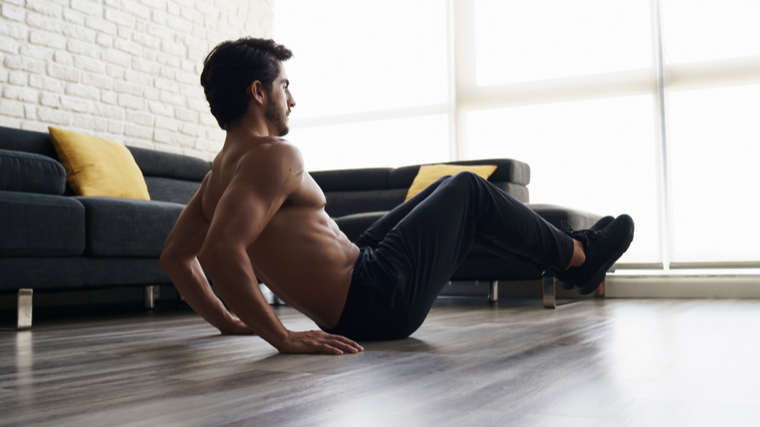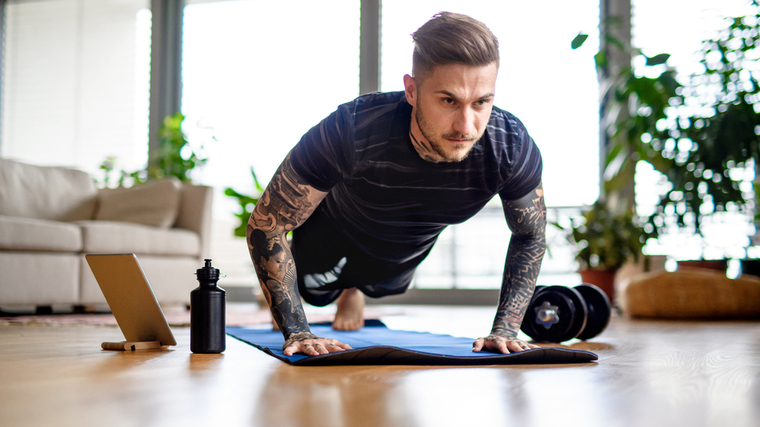Whether it’s a one-off session or your preferred training method, it’s highly likely that you’ll find yourself performing an at-home workout at some point. Stepping into your own basement or garage gym can be a dream come true. There’s no commute, no other people, and one doing curls in the squat rack. But in reality, you might be a little short on training equipment.

It’s still possible to get a great workout without fancy machines or an abundance of free weights. But training your upper body at home may take a bit more creativity than you’re used to. Here’s how to clock some serious time “pumping iron” without the lines, distractions, or noise of a box gym. These are five upper body home workouts — with options for weights and without weights.
Best At-Home Upper Body Workouts
- Best At-Home Arm Workout
- Best At-Home Chest Workout
- Best At-Home Shoulder Workout
- Best At-Home Back Workout
- Best At-Home Core Workout
Best At-Home Arm Workout
Training your arms might be one of the more challenging muscle groups without a dumbbell rack or cable machine. Without a fully-stocked home gym to help you isolate your arms, you’ll be targeting them primarily with more compound-style exercises.
Chin-ups just need a pull-up bar and work wonders for your biceps and grip strength. Push-ups and floor presses can help target your triceps. Just be prepared for a more taxing experience than your normal preacher curl.
The Workout
All you’ll need here is a chin-up bar, or in a pinch, some exposed ceiling joists in an unfinished basement. Given the full-body nature of these exercises, performing them for as many repetitions as possible (AMRAP) is your best bet here.
It’s worth pointing out that you should only perform these exercises on stable surfaces and with secure anchor points. Safety first.
- Chin-Up: 3xAMRAP
- Eccentric Tempo Chin-Up: 2xAMRAP
- Isometric Biceps Curl (Resistance Band OR Dumbbells): 3×15
- Close-Grip Push-Up OR Dumbbell Floor Press: 4×10
- Bench Dip: 3×12
- Bodyweight Skull Crusher: 2xAMRAP
If you have some dumbbells and are opting for floor presses, feel free to do more than 10 reps if your weights are light. Press and lower very slowly to help push yourself toward failure with each set.
Best At-Home Chest Workout
Blasting your chest from home can be a lot more similar to your gym workouts than you think. You can emulate most heavy pressing exercises with a variety of push-ups tailored to your strength or structure.
You can also use some floor sliders to help create the perfect at-home version of a pec flye. Prepare for a grueling chest workout. Jut be careful not to faceplant.
The Workout
Training your chest at home will employ a number of different training techniques. This means employing strategies such as tempo training and pause reps. You’ll also be manipulating how much of your own bodyweight is involved in each exercise to challenge yourself appropriately.
The goal of assigning these techniques is to keep the tension on your chest – stimulating your pecs with enough volume before you find it too hard to hold the right positions to make gains.
- Single-Arm Push-Up OR Floor Press: 3×10 per side
- Paused Push-Up: 3xAMRAP
- Bench Dip: 4×15
- Tempo Slider Pec Flye OR Floor Dumbbell Flye OR 1 ½ Rep Push-Up: 3xAMRAP
You might not have the type of floor surface at home to effectively use tempo sliders. Instead, you can opt for floor dumbbell flyes or 1 ½ rep push-ups for an added challenge.
Best At-Home Shoulder Workout
Your shoulders will be uniquely challenging to train without weights or with minimum equipment. You’ll need some pretty dynamic movements to roast them without a normal complement of cables or dumbbells.
Rest assured that you should still be able to accomplish what you need to with just what you can find in your own home. Taking advantage of different angles of movement will be a huge asset here.
The Workout
Being able to overload shoulder work without a lot of weights requires you have a trusty wall or set of stairs nearby. With that in mind, your core will also get a strong blast of work to keep you stable during your more inverted positions.
Throwing some pauses and tempo work in the right places are easy ways to add big (and safe) intensity to your workout.
- Handstand Push-Up OR Arnold Press: 3xAMRAP
- Paused Decline Push-Up OR Dumbbell Rear Delt Raise: 3×15
- IYTW: 3×12 per position
- Tempo Chaturanga Flow: 4×10
You might not be used to integrating yoga into your strength workout, but there’s no time like the present to learn. Your back will thank you.
Best At-Home Back Workout
Emulating all of the standard-issue back exercises without a gym may require a bit more thought than usual. The back as a muscle group is very difficult to isolate with just bodyweight due to how impactful small changes in grip can be.
However, with something as simple as a towel, you can still target a great spread of smaller muscle groups from your own home. Add some dumbbells to the mix if you’ve got them and you’re good to get those gains.
The Workout
Using pull-ups and chin-ups here will help hit your lats and mid back. Bringing in a study table can help you perform inverted rows. The addition of a towel will dramatically alter the muscle emphasis of each exercise by freeing up your grip orientation.
Lastly, some bread and butter prone Y-raises — with or without weights — can help finish off your upper back without a single dumbbell in sight.
- Pull-Up: 3xAMRAP
- Chin-Up: 2xAMRAP
- Table Inverted Row OR Dumbbell Row: 3×10
- Towel Inverted Row OR Towel Dumbbell Row: 3×10
- Prone Y-Raise: 2xAMRAP
If you’re opting for weighted prone Y-raises, you’ll probably want to use the lightest pair of dumbbells you’ve got. These are challenging even as a bodyweight exercise, and the point is the quality of movement rather than a heavy load.
Best At-Home Core Workout
Training your core from home is likely one of the easier transitions if you’re used to the gym. Plenty of core exercises that you do in the gym are easily recreatable in the comfort of your own home.
Don’t mistake that comfort for ease, though. If anything, this will be one of the harder workouts you’ll perform outside the gym.
The Workout
In a pinch, a simple variety of planks can provide the foundation of your at-home core routine. However, regular old planks don’t need to be the only go-to here. Spice things up with abdominal pikes, dynamic variations, and high-intensity body saws.
Grab a yoga mat and a towel — this one will be sweaty.
- Abdominal Pike: 3×15
- Thread-The-Needle: 3×10 per direction
- Plank Medley: 3×30 seconds per position
- Body Saw: 3×20 seconds
If you’ve never done a plank medley, brace yourself. These call for a side plank, a front plank, and finally the opposing side plank.
Building Your At-Home Workouts
Having access to machines and a wide range of free weights makes overloading each muscle a bit more straightforward. You can progressively overload your muscles by — among other methods — steadily increasing the weights you use for most exercises.

However, you can still use the principles of progressive overload while training from home with a minimal set-up. You’ll use many of the same tips and tricks for upping the intensity that you’d deploy at the gym.
Intensifiers
Upping your intensity without weights — or with minimal weights available — is far from impossible. Use strategies like 1 ½ reps and paused reps to get your muscles closer to failure.
This might mean using fewer reps than a workout may call for, depending on your experience level. As long as you’re pushing yourself hard and hitting a high rate of perceived exertion, you should be good to go.
Unilateral Training
Without a ton of weight to use, performing unilateral exercises immediately adds intensity to your workout. Unilateral exercises break your workout individual sides. This helps combat side-to-side strength and muscle imbalances.
When you’re using this strategy with your bodyweight, you’ll also be shifting more of your bodyweight to one side. Single-arm push-up variations are a great example here.
Tempo
You can make your workout immediately more challenging by adding slower eccentrics and pauses in the hardest positions of an exercise to reach muscular fatigue. This tempo training puts your muscles under tension for a longer period of time. That’s a great recipe for muscle growth, with or without heavy weights.
You can try adding a peak isometric contraction to help ensure repetition quality when you don’t have weights. Aim for a maximum voluntary contraction — squeezing your muscle at its peak as hard as you can for a good solid second — during each repetition.
AMRAP
Performing as many rounds or repetitions as possible can be a mainstay in your home training. This method will teach you to approach and hit failure even when you’re training with minimal equipment. Just be sure you’re not rushing through reps with sloppy form for the sake of a higher rep count. Quality over quantity will lead to better gains.
Rest Periods
Finally, minimizing how long you’re resting between sets can help increase your workout intensity dramatically. Not allowing a muscle to fully recover before hitting it again can really double up on the metabolic burn, speeding the rate at which you’ll experience muscle failure with each subsequent set.
Instead of going for two to three minutes of rest like you might in a gym, try limiting your downtime to 30 to 45 seconds when training at home.
Benefits of Training at Home
Training from home may seem like a bigger challenge than working out in a gym, but there are plenty of valuable perks to offset the lack of a barbell. Completely controlling your training environment, getting creative, and emphasizing the fundamentals are all huge benefits that you shouldn’t overlook.
Control Over Your Training Environment
Sometimes, you’re just not in the mood to fight over equipment or maneuver the hustle and bustle of a commercial gym. Having the option to train in the privacy of your own home, with full control over music selection, rest times, and cleanliness to your satisfaction can be hard to beat.

Not only that, but having your own private space can seriously boost the efficiency of your workouts.
Forced Creativity
There are definite pros and cons of working out from home without weights. A gym can help you target all the small muscle groups of the upper body with specific machines. Without these options, you will need to have a deeper understanding of your anatomy and much more creativity to get the job done.
In the long run, spending some time creating at-home workouts can ensure you’re able to make gains under any circumstances.
Master Your Mechanics
One of the biggest benefits of working out from home is how much time you’ll have to spend on calisthenics. Without machines or free weights, you will likely have to make exercises such as push-ups or pull-ups staples of your upper-body workouts. These exercises target many muscles of the upper body to varying degrees.
Moreover, bodyweight movements teach you to work as one synchronous unit. When or if you return to the weight room, you should notice your lat pulldowns feel much stronger after you’ve banged out a few (thousand) pull-ups.
Get After It at Home
Training from home is something you’re destined to tangle with at some point or another, either by necessity or just out of plain preference. Although it might be a bit more challenging to get a good workout at home than in a gym, using sound training principles at home can bridge the gap.
Being creative and making subtle adjustments to your usual exercises can have a huge impact on your ability to effectively target each muscle group of the upper body. Master your calisthenics, embrace the high-repetition grind, and you can make some serious upper body gains from the comfort of your own home.
Featured Image: Ground Picture / Shutterstock
The post The Best Upper-Body Workouts Workouts You Can Do At Home appeared first on BarBend.
